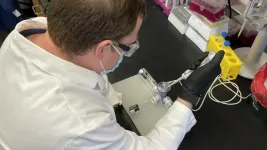(Press-News.org) Researchers at the Earlham Institute (EI) have created a new automated workflow using liquid handling robots to identify the genetic basis to prevent plant pathogens, which can be used on a much larger and rapid scale than current methods.
The new EI Biofoundry automated workflow gives scientists an enhanced visual check of genetic mutations linked to the control of crop disease, speeding up analysis to a fraction of the time compared to current methods - from months to weeks - accelerating development of novel products for crop protection in the agricultural industry.
Biosynthesis is the formation of chemical compounds by a living organism, or a biosynthetic process modeled on these reactions in living organisms.
The EI biofoundry, alongside the Truman Group at the John Innes Centre, used this workflow to experiment on the control of the common potato pathogen, Streptomyces scabies, which causes a devastating disease known as 'potato scab', by Pseudomonas sp. (bacteria).
The team screened 2,880 Pseudomonas sp. (isolated from potato field) mutants with the plant pathogen in just 11 hours, to identify and correlate the pathogen growth inhibition with a biosynthetic gene cluster within two weeks - indicating which genes were preventing the pathogen.
This approach will pinpoint genes involved in pathogen growth inhibition by bacteria, not the plant themselves; where either a bacterial strain or a molecule produced by a bacterial strain, would end up as the crop protection product.
The new EI automated workflow will allow scientists to scale-up the process of identifying Pseudomonas gene clusters that are responsible for restricting pathogen growth, avoiding human error, and increasing reproducibility and accuracy. The engineering biology workflow can also be applied to similar bacterial genome analyses.
Biofoundries integrate high-throughput software and hardware platforms with synthetic biology approaches to enable the design, execution and analyses of large-scale experiments. The unique and powerful combination of EI's Biofoundry infrastructure, expertise in molecular biology, and automation programming provide flexible resources for a wide range of workflows and research areas.
Co-Corresponding author of the study and Earlham BIO Foundry Manager Dr Jose A. Carrasco Lopez, said: "We demonstrate the applicability of biofoundries to molecular microbiology by using automated workflows to identify the genetic basis of growth inhibition of the plant pathogen Streptomyces scabies by a Pseudomonas strain isolated from a potato field.
"The EI Biofoundry generated workflow resulted in the identification of a gene cluster linked to the inhibitory effect on the potato pathogen which made the process much easier. By identifying the new genetic determinants, it opens the door to finding the metabolites involved in pathogen inhibition."
The new workflow will help scientists to understand how the genes are involved in the synthesis of the inhibitory metabolites, look at the species' inhibitory range and how these genes can be used for biocontrol, and how Pseudomonas is resistant to the very same inhibitory metabolite it's producing.
"Manual screenings are usually performed with pin replicators in the same plate, where many mutants are together in the presence of the pathogen," adds Dr Carrasco Lopez. "This means that a mutant in a non-related gene could mask the lack of inhibitory effect of a real-hit mutant by proximity."
"We solved this by creating individual assays for each mutant - this impacts the scientific community significantly, and provides enhanced control of crop pathogens based on biological processes which will translate into better crop yields."
Although these microbiological methods have been used before, with screening of well-known mutant libraries, this innovative study has for the first time used an automated screening process to reduce the required time and complete the process in weeks; whereas manually, it could take months.
Collaborator and first author Alaster Moffat, PhD student in the Truman Lab, who approached EI about the possibility of automating the biosynthetic screening, said: "We had previously been unable to identify genes important for inhibiting the growth of the pathogen using bioinformatics approaches, but this workflow allowed us to rapidly probe the effects of almost every accessory gene in the Pseudomonas isolate's genome directly, and find a novel biosynthetic gene cluster within a very short timeframe."
The EI Biofoundry plans to progress the study by creating workflow modifications to adapt to new projects and pathogens. "Once we have identified the gene cluster involved in the synthesis of this new metabolite," says Dr Carrasco Lopez, "scientists could mutate every single gene to identify functions and essential genes for metabolite synthesis. This can be applied to control plant pathogens and further improve the potato crop's yield, to test the species' inhibitory range of these metabolites and to identify new genes from other bacterial species linked to the impairment of other crop pathogens."
INFORMATION:
The paper, 'A biofoundry workflow for the identification of genetic determinants of microbial growth inhibition is published in Synthetic Biology.
ENDS
COSMIC, a multipurpose X-ray instrument at Lawrence Berkeley National Laboratory's (Berkeley Lab's) Advanced Light Source (ALS), has made headway in the scientific community since its launch less than 2 years ago, with groundbreaking contributions in fields ranging from batteries to biominerals.
COSMIC is the brightest X-ray beamline at the ALS, a synchrotron that generates intense light - from infrared to X-rays - and delivers it to dozens of beamlines to carry out a range of simultaneous science experiments. COSMIC's name is derived from coherent scattering and microscopy, which are two overarching X-ray techniques it is designed to carry out.
Its capabilities include ...
WASHINGTON (March 4, 2021)--Over the next month, 209 U.S. counties in the United States will need to implement crisis workforce strategies to deal with potentially dangerous shortfalls of intensive care unit doctors, according to a new analysis published today. The analysis draws on data from a just launched county-level hospital workforce estimator, one that takes into account the strain on staffing due to the COVID-19 pandemic.
"The shortages could occur just as public health officials warn that variants of the coronavirus are spreading in the United States and could trigger a sharp rise in the number of Americans infected," Clese Erikson, the principal investigator on the project and deputy director of the ...
An innovative cell-based treatment for cancer has been found promising for the control of infections caused by fungi. A study published in the journal Cytotherapy reports that the use of CAR (chimeric antigen receptor) T-cells programmed to “recognize” Cryptococcus spp. fungi was effective in combating infection in vitro and in mice.
C. gattii and C. neoformans are present in soil with dead organic matter and places contaminated by the droppings of pigeons and other birds. They cause systemic mycoses in the human organism. They can infect the lungs and central nervous ...
With a relatively minor genetic change, a new treatment developed by researchers at the Georgia Institute of Technology and Emory University appears to stop replication of both flu viruses and the virus that causes Covid-19. Best of all, the treatment could be delivered to the lungs via a nebulizer, making it easy for patients to administer themselves at home.
The therapy is based on a type of CRISPR, which normally allows researchers to target and edit specific portions of the genetic code, to target RNA molecules. In this case, the team used mRNA technology to code for a protein called Cas13a that destroys parts of the RNA genetic code that viruses use to replicate in cells in the lungs. It was developed by researchers in ...
UNIVERSITY PARK, Pa. -- While women can be drawn into farming for many reasons, researchers in Penn State's College of Agricultural Sciences have found that female-owned farms in the U.S. are more common in areas that are closer to urban markets, that engage in agritourism activity, and that offer greater access to childcare.
The number of farms operated by women has risen over the past two decades, said Claudia Schmidt, assistant professor of marketing and local/regional food systems.
The U.S. Department of Agriculture changed the way it counts the operators of farms in its most recent Census of Agriculture, allowing for up to four principal operators per farm. This has inflated the number of ...
COVID-19 is only the latest infectious disease to have had an outsized impact on human life. A new study employing ancient human DNA reveals how tuberculosis has affected European populations over the past 2,000 years, specifically the impact that disease has had on the human genome. This work, which publishes March 4 in the American Journal of Human Genetics, has implications for studying not only evolutionary genetics, but also how genetics can influence the immune system.
"Present-day humans are the descendants of those who have survived many things--climate changes and big ...
To succeed in mating, many male frogs sit in one place and call to their potential mates. But this raises an important question familiar to anyone trying to listen to someone talking at a busy cocktail party: how does a female hear and then find a choice male of her own species among all the irrelevant background noise, including the sound of other frog species? Now, researchers reporting March 4 in the journal Current Biology have found that they do it thanks to a set of lungs that, when inflated, reduce their eardrum's sensitivity to environmental noise in a specific frequency range, making it easier to zero in on the ...
Brain cells called astrocytes derived from the induced pluripotent stem cells of patients with bipolar disorder offer suboptimal support for neuronal activity. In a paper appearing March 4th in the journal Stem Cell Reports, researchers show that this malfunction can be traced to an inflammation-promoting molecule called interleukin-6 (IL-6), which is secreted by astrocytes. The results highlight the potential role of astrocyte-mediated inflammatory signaling in the psychiatric disease, although further investigation is needed.
"Our findings suggest that IL-6 may contribute to defects associated with bipolar disorder, opening new avenues for clinical intervention," says co-senior study author Fred Gage ...
New collaborative research from Northwestern University and Lund University may have people heading to their backyard instead of the store at the outset of this year's mosquito season.
Often used as an additive for cat toys and treats due to its euphoric and hallucinogenic effects on cats, catnip has also long been known for its powerful repellent action on insects, mosquitoes in particular. Recent research shows catnip compounds to be at least as effective as synthetic insect repellents such as DEET.
But until now, the mechanism that triggered insects' aversion to this common member of the mint family was unknown. In a paper ...
Existing gene drive technologies could be combined to help control the invasive grey squirrel population in the UK with little risk to other populations, according to a modelling study published in Scientific Reports.
Gene drives introduce genes into a population that have been changed to induce infertility in females, allowing for the control of population size. However, they face technical challenges, such as controlling the spread of altered genes as gene drive individuals mate with wild individuals, and the development of genetic resistance, which may render the gene drive ineffective.
To address these challenges, Nicky Faber and colleagues used computer modelling to investigate the effectiveness of a combination of three gene ...



